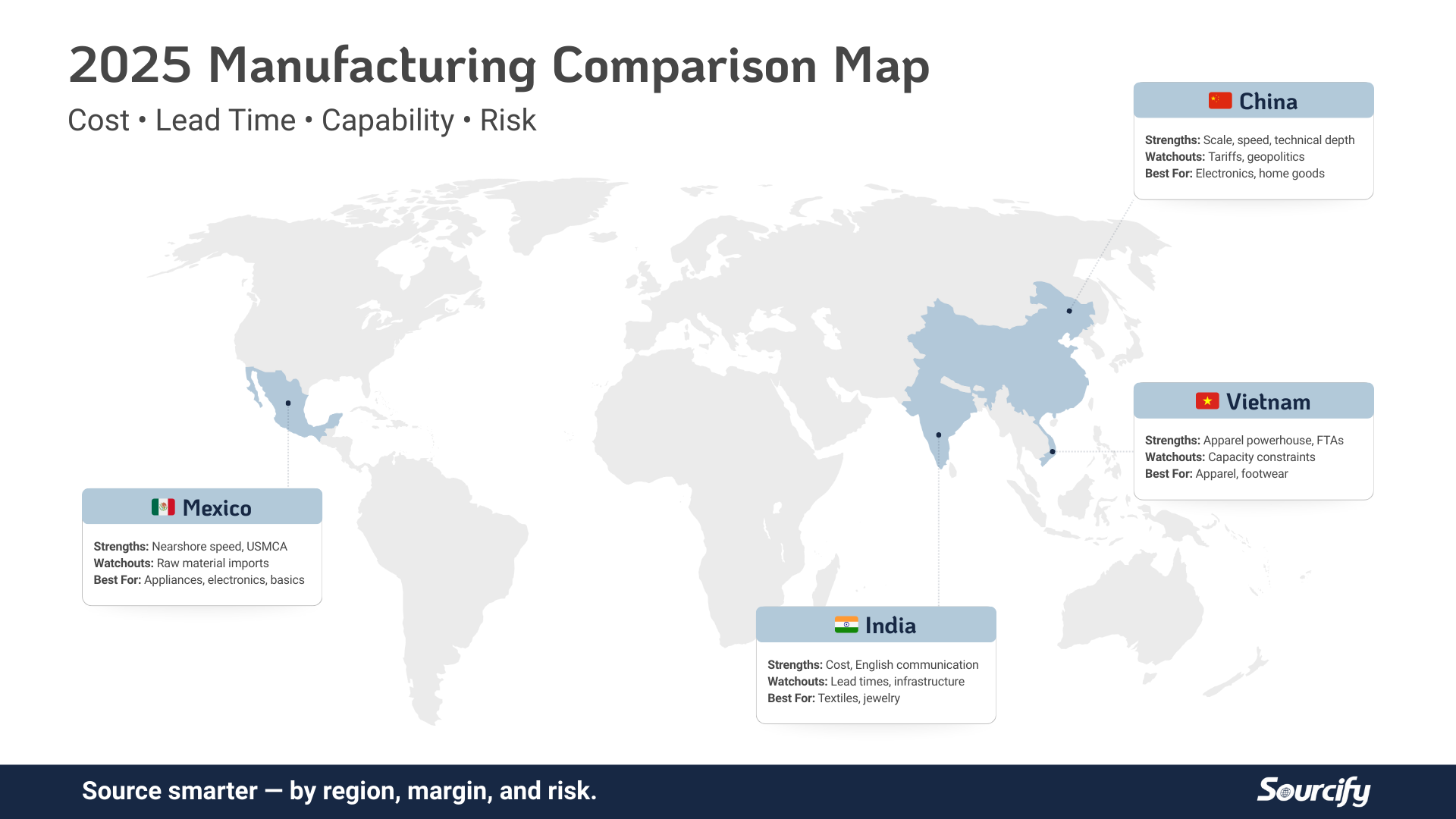In the whirlwind world of e-commerce, the location of your manufacturing operations can significantly impact your business’s success. As such, the choice between “offshoring” and “reshoring” becomes consequential. At Sourcify, we recognize the importance of understanding these concepts and how they can shape the landscape of your business operations.
The Basics
Offshoring refers to the practice of manufacturing or outsourcing specific business processes to countries with lower production costs, often overseas. This strategy gained momentum as companies sought cheaper labor, operational costs and tax breaks, often sacrificing proximity and control for financial gains.
Companies like Apple practice offshoring by manufacturing their iPhones in China, for example, where there is a lower cost of labor. However, labor costs can go up. In China, they rose by about 60% from 2010 through 2016.
Thus, reshoring becomes attractive.
Reshoring is the opposite of offshoring. It involves returning the production and manufacturing of goods or business processes to the company’s original country. This approach also has several benefits of its own. It creates manufacturing jobs and balances trade deficits while emphasizing local production, faster delivery times and improved quality control.
General Electric brought back all of its appliance manufacturing to Kentucky, five years after moving it all abroad. Even Apple has decided to pivot and begin manufacturing some of its computers and their components within the United States once again.
However, just as with offshoring, there are risks. Some products, particularly those native to other countries, are best left offshore. In addition, reshoring doesn’t always yield positive results, especially if a company underestimates the potential costs and the necessary logistical planning.
Poor management can yield to failed transitions in both offshoring and reshoring. Therefore, there are critical factors to consider in determining which approach is best for your business.
The Product
The nature of the product can significantly impact your decision. Products with high-value and complex manufacturing processes may benefit from reshoring to ensure quality control or protect intellectual property. Proximity to manufacturing facilities allows for tighter oversight and control over the production process.
This oversight enhances product quality and places you in a prime position to tackle unforeseen events like war or famine, allowing for smoother operations even in times of crisis.
On the other hand, it might be more advantageous to keep manufacturing offshore. Reshoring might be a bad idea if manufacturing process are not yet optimized. Perhaps the local regulatory environment might slow down production processes.
Deciding whether to offshore or reshore in e-commerce hinges on the product itself. Each product has unique needs, whether it’s about quality, quick delivery, or meeting specific rules. Ignoring these product-specific factors while making this decision risks compromising the product’s quality and consumer satisfaction.
It’s not just about cost; it’s about keeping the right balance between supply and demand, ensuring customer trust, and adapting to market needs. The product is the core, steering the success of e-commerce strategies, and overlooking its significance risks the brand’s reputation and market standing
The Market
For e-commerce businesses aiming to meet ever-demanding consumer expectations for swift shipping, local production can be a game-changer. Offshore deliveries should generally be those with longer lead times. On the other hand, reshoring might not be suitable for products that with quick turnaround times.
It thus becomes crucial to consider the market you are aiming for. Which approach promotes the most efficient turnaround from production to delivery? Supply chain considerations, including inventory management, should also play a role. Products with short lead times or high demands would be better suited for reshoring than those with low, steady demands and longer lead times.
Ultimately, you must also consider the preferences of your market. Consumers increasingly value locally made products. Depending on what the product is, both reshoring and offshoring could be positive marketing strategies in and of themselves. Products with a need for quick response to market changes or customization almost always benefit from being closer to the end market.
Ultimately, it always comes down to the bottom line. It is vital to consider the complete fiscal picture when deciding whether it is offshoring or reshoring that has more benefits than disadvantages.
The Cost
Which approach allows for the lowest production costs, including shipping, tariffs and other potential risks? Sometimes, the benefits of reshoring might outweigh the apparent savings of offshoring.
Keep an eye on changes in trade policies and geopolitical tensions. Those might affect the feasibility of offshoring and are vital to long-term business planning. The aforementioned rise in labor costs is another factor to consider as well. But so are potential tax breaks, lower real-estate, costs, workforce expertise and operational efficiency.
E-commerce is a nuanced and technical field that requires a flexible approach. The dynamics of the global markets, geopolitics, labor pools and market requirements are almost always in a state of flux. And beyond that, every single business is different.
That is why, at Sourcify, we work closely with businesses to evaluate their unique needs and help devise the specific strategies that will optimize all vital processes from manufacturing to delivery. Our tailored solutions will balance cost-effectiveness with quality and efficiency.
A flexible approach will empower businesses to make informed decisions that will help you reach your long-term growth objectives. In the e-commerce realm, where speed, quality, and customer satisfaction reign supreme, the choice between reshoring and offshoring is pivotal.
Each approach presents its own set of advantages and challenges, demanding a thoughtful analysis based on a company’s specific circumstances and goals.




